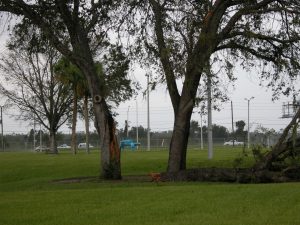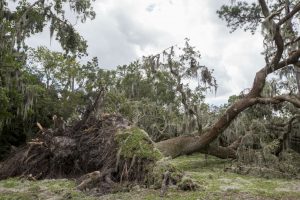We all know we need to prepare ourselves and our homes for hurricanes, but have you ever thought about preparing your landscape for these powerful storms?
Building codes exist to reduce damage from strong winds and high water on structures, but there are no standards for designing and maintaining hurricane-resistant landscapes. However, by choosing the right plants and maintaining them correctly, we can greatly reduce storm damage.
Select storm-sustaining trees for their root development, mass, density and growth characteristics.  Most of Florida’s native trees and plants are good choices. These plants prove resistant to strong winds by surviving previous storms.
Most of Florida’s native trees and plants are good choices. These plants prove resistant to strong winds by surviving previous storms.
What makes a tree a storm “survivor”?
A storm “survivor” tree is one that is compact, with a low center of gravity, has a strong, sturdy trunk and a large, deep root system. Our native live oak is a great example of the “survivor” tree, given the right environment and proper care throughout its life.
On the other hand, the “weakest link” of landscapes during storms is a tree that has a high center of gravity with a dense canopy, a weak trunk and shallow roots. Tall, slender pine trees are examples of the “weakest link”, especially those that once belonged to a pine forest before suburban development. These pines relied on one another for wind resistance and support during storms. Without each other, they are unprotected from the storm.
Trees that are thought to be hurricane-resistant may still be vulnerable to strong winds. Construction damage, poor growing conditions, small root zones, and disease or insect problems make trees susceptible to toppling during storms.
Poor designed landscapes are a hazard during a hurricane, however a well-designed one is an asset. Strong, dense landscape trees deflect wind from structures during storms. Place new plantings far enough from buildings and utilities so they can sway in the strong winds and plant thick, dense hedges in front of trees. The shrubs act as a wall to divert winds from trees and debris from buildings.
Trees less than a year old are more susceptible to hurricane damage than older trees. They are not as strong and do not have a deep root system. Anchor these trees with tree supports if a storm threatens.
 Keep your Landscapes & Trees Properly Maintained
Keep your Landscapes & Trees Properly Maintained
Provide proper maintenance during the life of all trees. The first step is to provide the tree, with good growing conditions and to keep it as healthy as you can, free of insects and diseases. Second, maintain a properly pruned tree. A strong, deep-rooted tree may not fall during a storm, but weak limbs in the canopy may. Broken, dead and damaged limbs can be torn from trees during a storm and turned into dangerous projectiles. Even “survivors” can grow very large and unbalanced, which could make them hazards during storms.
Create a sturdy, well-spaced framework of healthy branches with proper pruning. It is important for a tree to have a central leader with no narrow forks or branches that leave the trunk at an acute angle. Limb crotches should be between 45 and 90 degrees. Narrow V-shaped crotches have the tendency to split.
When a storm is on the horizon, homeowners who have kept their trees properly pruned and in proportion have little to do to prepare. The neglected tree that has become immensely overgrown is another matter. Just remember the “survivor” trees are hurricane-resistant, not hurricane-proof.
 0
0
